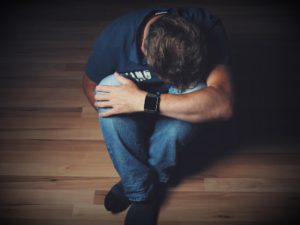 The terms “manic depression” and “manic depressive” get tossed around quite a bit. This is despite the fact that the real technical title of the diagnosis got changed to bipolar disorder back in 1980. Bipolar depression exists in the context of a larger bipolar disorder.
The terms “manic depression” and “manic depressive” get tossed around quite a bit. This is despite the fact that the real technical title of the diagnosis got changed to bipolar disorder back in 1980. Bipolar depression exists in the context of a larger bipolar disorder.
While a bipolar disorder may seem like a far-off concept, it may be closer to home than you think. A study by Harvard Medical School in 2007 found that 2.8% of American adults experience bipolar disorder.
In 2013, The American Psychological Association estimated that 0.6% are diagnosed with bipolar I and 0.8% are diagnosed with bipolar II. Considering the larger size of the US, these small percentages show there are plenty of individuals out there suffering from these types of disorder. San Diego Christian Counseling can offer support for those dealing with bipolar disorders.
What Exactly is Bipolar Disorder?
According to the Diagnostic and Statistical Manual of Mental Disorders, 5th Edition, there are three types of Bipolar disorder: Bipolar I Disorder, Bipolar II Disorder, and Cyclothymic Disorder.
Bipolar I Disorder
In order for someone to be diagnosed with Bipolar I Disorder, they must have experienced one manic episode in their lifetime. (APA, 2013). A manic episode consists of a major increase in energy and an elevated or irritable mood, both of which last for at least a week.
In some circumstances, Bipolar I Disorder will vacillate between moods quickly going from depressed, to angry, to euphoric very quickly.
Symptoms of mania may include (APA, 2013):
- Higher levels of self-esteem this can be as simply as higher levels of self-confidence and go all the way up to a delusional god complex.
- Talking more or speaking loudly and rapidly if angry, this may look like a rant.
- Getting less sleep, but still feeling rested (staying up all night). This lack of sleep, according to the DSM-5 authors, is a common symptom for manic episodes and can foreshadow a manic episode.
- Ceaseless thoughts
- More easily distracted
- Feeling restless
- Increased activity (e.g., fixation on new hobbies, working all night). An increase in sex drive is also common.
- Risky behavior (e.g. reckless driving, sexual promiscuity, gambling, shopping binges)
For activity and behavior to be considered a manic episode, the changes in behavior and mood must cause some level of impairment (relationally, financially, physically) or require hospitalization. If significant changes like these are only related to a substance or medical condition, then they are not the result of a bipolar disorder.
An episode of major depression is not always associated with bipolar I disorder. Although, it is not uncommon for someone who has experienced a manic episode to also experience a major depressive episode.
Major Depressive Episode
 Bipolar depression is an episode of major depression that takes place in association with a hypomanic or manic episode. A major depressive episode consists of a group of symptoms that are present overtime for at least two weeks. (APA, 2013).
Bipolar depression is an episode of major depression that takes place in association with a hypomanic or manic episode. A major depressive episode consists of a group of symptoms that are present overtime for at least two weeks. (APA, 2013).
Common symptoms of depression include (APA, 2013):
- Feeling depressed or in despair
- Lack of interest in hobbies
- Difficulty concentrating or making decisions
- A sense of worthlessness or inappropriate guilt
- Thoughts of suicide or recurring thinking about death
- A significant change in weight, either weight loss or weight gain
- Altered sleep schedule: Either sleeping too much or too little.
- Decreased psychomotor activity or more agitated psychomotor activity
- Increased fatigue and feelings of exhaustion
Someone suffering from a major depressive disorder will be considered bipolar if they also experience a manic or hypomanic episode. While the symptoms of mania, or hypomania, can still exist with MDD, the full criteria cannot be met for the diagnosis to remain MDD.
Bipolar II Disorder
Bipolar II disorder is similar to Bipolar I disorder but with a slight difference. Bipolar II is diagnosed when someone has had both a major depressive episode and a hypomanic episode. A hypomanic episode is very similar to a manic episode, however, it only needs to last at least four days to be diagnosed. Symptoms of a hypomanic episode are very similar to that of a manic episode but do not cause the same level of impairment or result in hospitalization.
Cyclothymic Disorder
Cyclothymic disorder is more complex. This disorder is when someone experiences hypomanic symptoms and a period of depressive symptoms over at least two years, but never experiences the full hypomanic criteria or a major depressive episode.
For children and teenagers, the time frame is shortened to one year. Someone dealing with a cyclothymic disorder will never fully meet the criteria for major depression, a hypomanic episode, or manic episode, making it somewhat harder to diagnose (APA, 2013).
Bipolar Disorders and Suicide
 Bipolar disorder is serious because it increases the risk of suicide. It has been shown that people with bipolar disorder are 15 times more likely to commit suicide. (APA, 2013). An even more sobering statistic is that 1 in 3 people diagnosed with a Bipolar II disorder report having attempted to commit suicide during their lifetime (APA, 2013).
Bipolar disorder is serious because it increases the risk of suicide. It has been shown that people with bipolar disorder are 15 times more likely to commit suicide. (APA, 2013). An even more sobering statistic is that 1 in 3 people diagnosed with a Bipolar II disorder report having attempted to commit suicide during their lifetime (APA, 2013).
Suicide is the greatest risk for those who have previously attempted it and who have experienced depression within a year, according to the DSM 5 authors. Suicidal thoughts will not always be present, but they can be and often are important warning signs of suicidal thinking.
Examples of warning signs include (SAMHSA, 2019; The American Foundation for Suicide Prevention, 2019):
- Verbalizing thoughts about dying or wanting to commit suicide.
- Saying they have no reason to keep living
- Looking up ways to commit suicide
- A sense of “unbearable pain” or “being trapped”
- Increased use of substances or alcohol
- Expressing that they feel like a burden
- A significant shift in sleep schedule (either more or less than usual)
- Anxiety and agitation
- Reckless behavior
- Increased isolation from friends and family
- Extreme anger, for example, stating a need to get revenge
- Extreme swings in mood
- Telling people goodbye
- Getting rid of belongings
- Irritability, depression, humiliation
- Loss of interest in activities
By no means is this list comprehensive, other warning signs can also be present that are not listed. What is important is to remember to seek professional help if you think suicidal thinking is present. If you are aware of someone who is actively suicidal, then you should immediately contact 9-1-1 or go to a local emergency room.
Coping with Bipolar Depression
If you are dealing with the symptom of depression brought on by bipolar disorders, consider these strategies to help you cope:
- Learn about your diagnosis so you can begin to understand your triggers. A lot of information is available on bipolar disorders and knowing more can help your process and deal with the symptoms. A doctor or therapist can also help you get headed in the right direction.
 Keep your goals attainable. Depression often makes people lose motivation and interest in life. But giving into a sense of helplessness actually makes depression worse. By making realistic, daily goals, you can help break through some of the despair.
Keep your goals attainable. Depression often makes people lose motivation and interest in life. But giving into a sense of helplessness actually makes depression worse. By making realistic, daily goals, you can help break through some of the despair.- Be with people, don’t go this alone. Isolation and loneliness only make depression worse. As relational beings, we are meant to be with people and find support through family and friends. Reach out to your community and find ways to surround yourself with people.
- Keep track of what is going through your mind. Depression can cause negative thinking, which only makes things worse. Try to analyze your thoughts so you can discern what you are thinking and why.
- If you’re thoughts feel uncontrollable, mindfulness can help you take back control. Mindfulness can be anything from sitting in silence to meditation, to yoga. There is a lot of free online content that can help you develop the practice of mindfulness.
- Relaxation exercises like intentional breathing or guided meditation.
- Exercise has been proven to provide many health benefits. Consult your physician to find out what is best for you.
- Taking time to process your experience through self-expression (e.g. art, journaling, dance)
- Reading and meditating on the Bible:
Don’t be afraid, for I am with you. Don’t be discouraged, for I am your God. I will strengthen you and help you. I will hold you up with my victorious right hand. – Isaiah 41:10
Then Jesus said, “Come to me, all of you who are weary and carry heavy burdens, and I will give you rest. – Matthew 11:28
Come quickly, LORD, and answer me, for my depression deepens. Don’t turn away from me, or I will die. Let me hear of your unfailing love each morning, for I am trusting you. Show me where to walk, for I give myself to you.. – Psalm 143:7-8
How to Treat Bipolar Depression
While it might be tempting to ignore the symptoms of bipolar disorder, it isn’t helpful to do so. If you know someone who is experiencing bipolar disorder symptoms, or see them in yourself, it is best to get diagnosed and receive medical treatment. The disorder will only worsen if untreated. (NAMI, 2019).
To achieve a proper diagnosis, you will need to receive a medical evaluation to ensure it is bipolar disorder and not something else. The treatment for a bipolar disorder will likely be a combination of psychotherapy and medication management.
One of the most effective approaches for treating bipolar disorder is cognitive behavioral therapy (CBT). CBT teaches people how to alter their way of thinking. It allows you to combat negative ways of thinking and behaving, thereby helping you to cope with your emotions in a healthy way.
The role of a therapist is to be an outsider observer who can help you explore what triggers episodes so you can learn to manage your stress and triggers. This can include a variety of different techniques and strategies. Another helpful form of therapy is family therapy because it can teach families about the disorder while also exploring different family dynamics that may lead to increased levels of stress.
Conclusion
Bipolar disorders are no small thing. They can carry very serious consequences. That being said, they are treatable. If you think someone you love is dealing with a bipolar disorder, then get in contact with a counselor at San Diego Christian Counseling today. We are ready to walk with you down the road of healing and growth.
“Alone,” courtesy of Zulmaury Saavedra, unsplash.com, CC0 License; “Depressed,” courtesy of HolgersFotographie, pixabay.com, CC0 License; “Snowstorm,” Courtesy of Magda Ehlers, Pexels.com, CC0 License; “Depressed”, Courtesy of Rawpixel, Unsplash.com, CC0 License


